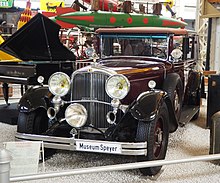Maybach Zeppelin DS 7
| Maybach | |
|---|---|
|
Maybach Zeppelin DS 7 from 1930
|
|
| Zeppelin DS 7 | |
| Production period: | 1930-1934 |
| Class : | Upper class |
| Body versions : | Limousine , Pullman limousine , cabriolet |
| Engines: |
Otto engines : 7.0 liters (110 kW) |
| Length: | 5370-5500 mm |
| Width: | 1845 mm |
| Height: | 1800 mm |
| Wheelbase : | 3660-3735 mm |
| Empty weight : | 2800 kg |
| Previous model | Maybach 12 |
| successor | Maybach Zeppelin DS 8 |
The Maybach Zeppelin DS 7 are luxury- class passenger cars with twelve-cylinder V-engines, which were built in numerous variants from 1930 to 1934 by Maybach-Motorenbau in Friedrichshafen / Bodensee.
description
At the luxury brand Maybach of the 1930s, buyers had a wide range of options to have their vehicle “bodyworked” according to their individual requirements and personal style.
The vehicles had a semi-automatic 3-speed gearbox with gear preselection using small levers on the steering column and an additional overdrive gear, which was also engaged with a lever on the steering column.
The switching process can be found in the operating instructions; When starting off, after depressing the clutch, the selector lever on the steering column had to be set to low gear, the gear lever had to be set to gear selection (forward or reverse gear) and then engaged. The further gears were shifted automatically after the gas was released by preselecting the desired gear on the steering column. In this way it was possible to switch up and down. The driver did not need to operate the clutch, he just had to watch out for the synchronization of the gearbox, ie the engine had to be turned down when shifting up and brought up to speed when shifting down . To stop the vehicle, the operating instructions recommended: take off the accelerator, apply the foot brake, disengage the clutch, put the gear lever in neutral, apply the handbrake and set both levers on the steering column to starting gear.
The overdrive had been simplified since the Maybach 12 so that the driver can only switch the overdrive on or off by moving the lever. The actual switching process is then controlled by negative pressure.
Technical specifications
| Parameters | Data |
| engine | V12 light alloy, 60 ° cylinder angle, crankshaft with 8 plain bearings |
| Bore / stroke | 86/100 mm; Light alloy pistons |
| Displacement | 6962 cc |
| compression | 1: 5.67 |
| power | 110 kW (150 PS) at 2800 rpm |
| cylinder | exchangeable cast iron bushings |
| Valves | Inlet / outlet valve hanging; 1 camshaft with 7 bearings |
| Carburetor | 2 Solex double stage carburetors |
| cooling | Water cooling / pump, thermostatic cooler, blinds |
| frame | U-profile, steel press frame |
| feathers | long semi-elliptical springs, in wide sliding shoes on steel rollers, hydraulic, double-acting shock absorbers |
| Front axle | Fist axis in double-T profile made of chrome-nickel steel |
| Rear axle | Rigid axle with light alloy steel axle carrier |
| steering | Flutter-proof screw steering, left or right as desired |
| Foot brake | Vacuum servo brake, acting mechanically on all four wheels |
| bikes | Steel discs or wire spokes, 2 spare wheels |
| tires | Medium pressure, DT rim, 7 × 20 and 7.5 × 20 |
| coupling | Single-disc dry clutch |
| transmission | Maybach SG high-speed transmission, four noiseless gears |
| arrangement | inserted into the cardan thrust tube |
| Number of gears | 4 forward; 1 backwards |
| drive | about rear wheels |
| wheelbase | 3.66-3.735 m |
| Gauge | front / rear 1.52 m |
| length | over everything including bumpers 5.37–5.5 m |
| Width / height | over fenders 1.82 m / approx. 1.80 m |
| Weights | Chassis 1940–2110 kg, car approx. 2800 kg, payload approx. 990 kg |
| V max | approx. 145 km / h, depending on the structure and translation |
| consumption | approx. 27 liters / 100 km |
| Oil consumption | approx. 0.4 liters / 100 km |
| tank | in the rear, 135 liters, 2 fuel pumps |
literature
- Harry Niemann : Karl Maybach - his engines and automobiles. Motorbuch Verlag, Stuttgart 2004, ISBN 3-613-02457-8 , pp. 100-105.
- Werner Oswald : German cars. Volume 2: 1920-1945. New edition. Motorbuch Verlag, Stuttgart 2001, ISBN 3-613-02170-6 , pp. 194-196.
Web links
- Maybach Zeppelin DS 7 . In: Sinsheim.Technik-Museum.de
- Maybach Zeppelin DS 7 . In: Traumautoarchiv.de
- Maybach Zeppelin DS 7 . In: Autoevolution.com
- Maybach Zeppelin DS 7 Cabriolet . In: Autoevolution.com
Individual evidence
- ↑ Harry Niemann: Karl Maybach his engines and automobiles. Motorbuch, Stuttgart 2004, ISBN 3-613-02457-8 , p. 104.
- ↑ Harry Niemann: Karl Maybach his engines and automobiles. Motorbuch, Stuttgart 2004, ISBN 3-613-02457-8 , p. 96.


